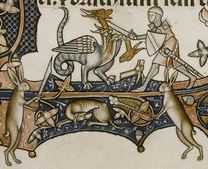 This is a Chimera from an ancient bestiary; a fictional animal that we may retroactively add to the book of life.
This is a Chimera from an ancient bestiary; a fictional animal that we may retroactively add to the book of life.
The chimera is a creature made of the parts of other animals (the lion, goat, and serpent). It is imaginary, yet deeply rooted in the symbolism of western thought and literature. Now it is a little less fictional.
CRISPR-Cas9 has been revolutionary, making gene editing, a process which is exactly as complex and difficult as it sounds, relatively simple. Some scientists want to use it make human organs inside of pigs. A steady supply of organs would save millions of lives.
How they'd do it:
It is that last step that has people concerned. As of now, there doesn't seem to be complete control over exactly which organs develop. It could be a kidney. Or, it could be a brain; a human brain in a pigs body.
CRISPR-Cas9 has been revolutionary, making gene editing, a process which is exactly as complex and difficult as it sounds, relatively simple. Some scientists want to use it make human organs inside of pigs. A steady supply of organs would save millions of lives.
How they'd do it:
- Find the gene in the pig embryo responsible for a particular organ and delete it.
- Inject iPS cells, similar to stem cells except taken from human skin, into the embryo, and implant in the mother pig.
- Remove the chimeric embryo after the 28th day to look for basic organ development.
It is that last step that has people concerned. As of now, there doesn't seem to be complete control over exactly which organs develop. It could be a kidney. Or, it could be a brain; a human brain in a pigs body.
"If you have pigs with partly human brains you would have animals that might actually have consciousness like a human," Newman says. "It might have human-type needs. We don't really know." -Pablo Ross of the University of California
A quick primer on CRISPR-Cas9
